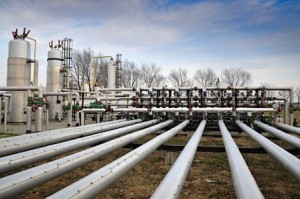 Natural gas futures traded higher during early hours in Europe today. Previously, contracts closed higher for the week on Friday, after a massive price increase on Thursday offset losses for all the other sessions.
Natural gas futures traded higher during early hours in Europe today. Previously, contracts closed higher for the week on Friday, after a massive price increase on Thursday offset losses for all the other sessions.
Front month natural gas futures, due in July, gained 0.72% at the New York Mercantile Exchange to trade for $4.773 per million British thermal units at 9:45 GMT. Prices ranged from $4.757 to a five-week high at $4.886 per mBtu. The contract closed about 0.8% higher for the week on Friday, after a massive 5.63% daily increase on Thursday.
Natural gas surged by the most in almost four months on Thursday after the Energy Information Administration reported that US natural gas inventories received a smaller-than-expected injection during the week ended June 6th. The government agency’s report showed stockpiles added 107 billion cubic feet (bcf), trailing projections for a 109-bcf gain. Nationwide natural gas inventories stood at 1.606 trillion cubic feet, the lowest level for this time of the year since 2003. Albeit consistently narrowing, inventories are still running a 31.2% deficit to the previous year’s level and a 35.3% deficit to the five-year average.
Tom Saal, senior vice president of energy trading at FCStone Latin America LLC in Miami, said for Bloomberg: “We are in a period where we don’t have a lot of extreme-weather demand but extreme demand could be right around the corner. The bottom line is the uncertainty about how much gas we are going to have at the end of the season. The bears are looking at injections that are bigger than the ones we have seen.”
The EIA raised its inventories levels forecast through November, when heating demand picks up, to 3.424 trillion cubic feet, which would be more then enough to cover a harsh winter. This will require average injections of 87 billion cubic feet over the next 21 weeks, compared to the average injections of 78 bcf since April.
US weather report
The Midwest will see showers and thunderstorms this week, with mostly above-seasonal temperatures. In the Northeast, readings will be about the average, with mostly dry and sunny weather, before temperatures surge into the upper 80s and 90s on Tuesday and Wednesday, spurring electricity demand to power air conditioners. The South will see dry weather, with mostly seasonal readings but heat will build up in the upcoming week with highs again in the upper 80s and lower 90s. In the West, there will be showers and thunderstorms across some areas, with temperatures remaining near or below seasonal in a range between 60 and 70 degrees Fahrenheit.
According to AccuWeather.com, New York will have a sunny and pleasant day, with temperatures ranging 67-82 degrees Fahrenheit, a few above average. A warm up of several degrees is expected for the next few days. Boston will also see sunny and warm days this week. Temperatures will range 62-76 today, and mid 60s-80 over the following few days.
Chicago will be sunny today, temps between 70 and 82, just above average. Starting tomorrow readings will rise to several above usual, but clouds and thunderstorms will make appearance. Down South, Houston will have sunny weather and seasonal readings this week, ranging mid-to-upper 70s – 90, with the possibility of some thunderstorms midweek.
Over on the West Coast, Los Angeles will be cooler than normal over the first half of the week, with readings reaching no higher than mid 70s, a few below average. Temperatures will slowly climb to enter average range late this week or early in the next one. Seattle will be mostly cloudy, with showers, and cooler than normal today, with temperatures several below average at 51-62 degrees. A warming up to usual readings is expected over the following days.
Technical view
According to Binary Tribune’s daily analysis , in case natural gas for settlement in July penetrates the first resistance level at $4.783 per million British thermal units, it will encounter next resistance at $4.826. If breached, upside movement will probably attempt to advance to $4.860 per mBtu.
If the energy source drops below its first resistance level at $4.706 per mBtu, it will see support at $4.672. If the second key support zone is breached, the power-station fuel’s downward movement may extend to $4.629 per mBtu.





